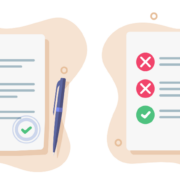Six Step MPRE Test-taking Strategy
Six Step MPRE Test-taking Strategy
Passing the MPRE is not only about knowing the model rules of ethics but a proper testing strategy matters too. The MPRE is distinct from the bar exam in subject matter, the length of the test, and the timing for each question. The best test-taking strategy to apply to each exam also differs. This post will walk you through a 6-step approach to effectively and correctly answer each MPRE question. With this approach, you can go into the MPRE confidently knowing you are capitalizing on the law you know and compensating for what law you may not know. Here is a six step MPRE test-taking strategy to help you on exam day!
Six Step MPRE Test-taking Strategy
1. Read the Fact Pattern Actively
Starting at the beginning of the question, read the fact pattern actively looking for key actors, actions, and circumstances that will cue you to the ethical issue the question is testing. The MPRE is concerned about the actions of lawyers, so make sure to pay special attention to the actions of any lawyer in the fact pattern. Try to not be confused by the bad acts of non-lawyers that may try to distract you from the main issue! Because of the many exceptions within the rules and the lists of factors to consider, the correct answer is often dependent on one line in the fact pattern. Read the fact pattern carefully so you don’t miss a factor that may change how you answer the question.
If you read for speed rather than actively noting the key elements, you will step right into the trap the question intended to set. An active read of the fact pattern will allow you to catch all the key details and prevent you from wasting time re-reading the question.
2. Read the Call of the Question
This step is short and sweet and should take no time at all. The “call of the question” follows the fact pattern and provides you with the actual question you must answer. The call of the question for the MPRE is almost always one of two questions:
(a) Was the lawyer’s [attorney’s; judge’s; etc.] conduct proper?; or
(b) Is the lawyer [attorney; judge, etc.] subject to discipline?
Essentially, the question will always be asking, “Was the lawyer’s action right or wrong?” Because the MPRE questions are so predictable, the only thing you need to note for this step is whether the question is in the positive (“proper”) or the negative (“subject to discipline”).
3. Recall the Rule
The next step is crucial and requires a good recollection of the rules. If you are well-prepared, as you actively read the fact pattern you will recognize the rule the question is testing. Recall that rule and its exceptions. But what if you just cannot remember the rule or whether an exception applies? Instead of recalling a rule, recall a general principle. What is the lawyer’s action and what ethical dilemma does it pose? Based on what you do know, can you recall a general principle that would apply to this situation? (e.g. Lawyers should never deceive, so an advertisement that implies misinformation is likely unethical).
4. Predict the Answer
After recalling the rule, you should be able to predict the answer. The best strategy is to predict the answer before looking at the answer choices. This will save time and allows you to avoid being tricked by shrewdly worded answer choices. Just like the call of the question, the answer choices are predictable in part: there will likely be two “yes” options and two “no” options. If you cannot predict the answer in its entirety (Yes, because…), you should at least be able to narrow the answer choices down to the two “yes” or the two “no” answers (“yes, the lawyer is subject to discipline”, or “no, the conduct was proper.”)
5. Eliminate the Wrong Answers
Now that you have predicted the answer, you can eliminate the wrong answers and narrow your analysis to two options rather than four. This step may be quick, but we do recommend you read the answer choice in its entirety before eliminating it. Many a test-taker has been alerted to a fact in the fact pattern because it is mentioned in the answer’s reasoning. If an answer choice mentions a fact that would make an otherwise ethical action unethical (or vice versa), pause and make sure you did not overlook this crucial fact in the fact pattern!
6. Choose the Right Answer
The last naturally flows from the first 5 steps: choose the right answer based on your recollection of the rule and your predicted answer. If you have done all of the above, you can choose the right answer with confidence knowing you have done your best with what you know. Then you can move on and not waste time looking back.
This 6-step approach is a sure way of answering the MPRE questions with confidence. A good test-taking strategy should not take the place of meaningful studying, but it will certainly help you maximize your score. If you need further help with strategy, learning the law, or you are interested in taking our free MPRE course, check out JD Advising’s MPRE resources!
Looking to Ace the MPRE?
- Enroll in our 5-star rated free MPRE Course, complete with expert guidance, an exclusive outline, practice questions, and a one-sheet.
- Tackle the Real MPRE questions — the gold standard for test preparation.
- Elevate your preparation with personalized MPRE private tutoring, featuring a tailored study plan and dedicated MPRE outline.
- Dive into our assortment of complimentary top-notch MPRE resources for your success.








Leave a Reply
Want to join the discussion?Feel free to contribute!